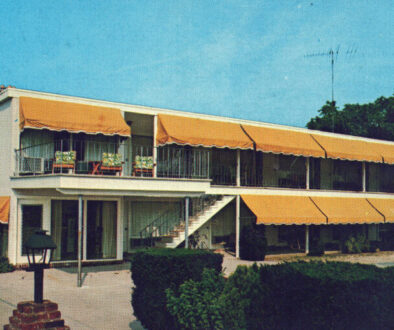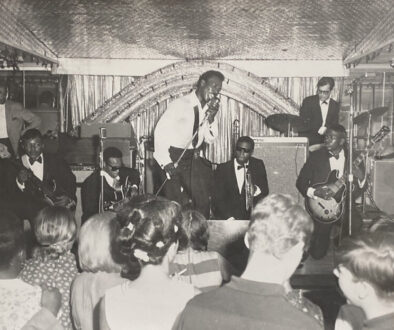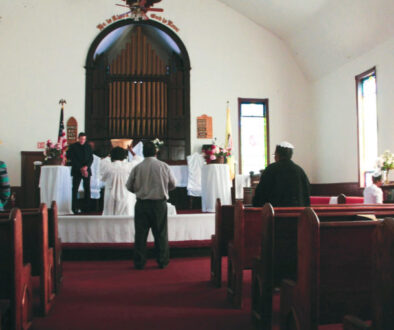Cottage Industry
How two small houses became a gift of history

While the tagline “America’s Oldest Seaside Resort” certainly indicates that Cape May has historical significance, it’s hardly unusual for guests and locals alike to bypass thoughts of the past when confronted with the burgeoning music scene, incredible arts, and beautiful beaches of Cape May in the present. And while it’s natural to consider what Cape May offers now, we would be foolish if we didn’t also acknowledge its grand history.
For the Mid-Atlantic Center for the Arts and Humanities, or MAC as it’s commonly called, promoting and celebrating Cape May’s rich history are par for the course.
“We began 50 years ago trying to save the Emlen Physick Estate,” says Tom Carroll, current president of MAC, on the Victorian house-turned-museum that dates back to 1879.
That first project took 25 years, but culminated in resounding success. The Emlen Physick Estate is a historic tourist destination, home to several MAC offices, and the site of numerous festivals that occur throughout the year.
While the Emlen Physick Estate can be seen as the crown jewel in the cap of MAC, the organization also operates the Cape May Lighthouse and the World War II Lookout Tower. MAC staff manages activities, events, and maintenance of all the sites, but does not own them—it leases them from the city.
However, with a 50-year anniversary on the horizon, MAC finds itself on the receiving end of a tremendous act of generosity, and with that, a home (or two) of its own.
Back in 2004, Chris and Dave Clemans bought two cottages on Batts Lane: the Owen Coachman House, so named for the free black farmer and laborer who purchased and moved the house to Batts Lane; and the Church-Matthews House, named for the subsequent owner of the Coachman House, Silas Church, and his daughter, Melinda Matthews. Though the cottages look quite similar from the front, they were actually built in different centuries—the Owen Coachman cottage, most certainly a whaler’s cottage, dates back to circa 1700, while the Church-Matthews cottage was built around 1840.
Though the houses had historical significance, they were most recently used as part-time residential homes. And they were hardly in “preservation” condition.



“My assistant came in and said that the properties had been listed, and she said, ‘You have to buy them or someone is going to tear them down’,” says Chris Clemans, whose work as a real estate broker with Sotheby’s has her tapped into the local housing market.
“So we did…we bought them to save them,” she adds.
It wasn’t the first labor of love for the Clemanses, who live in the Jonathan Pyne House, also known as Lindenwood. Built in 1694, it’s the oldest house in Cape May.
And while Dave Clemans is a fine artist and former restaurateur, it’s clear he’s also got a passion—and a knack—for preservation.
“I love old things, and I do everything in the world to preserve them because I think you learn from the past what you need to know for the future,” says Dave.
And nowhere are Dave and Chris’s commitment to preserving the past as evident as in the cottages at Batts Lane. While they purchased the houses 15 years ago, it’s what they’ve done with them since then that’s truly inspiring.
After buying the cottages, the Clemanses began the 13-month renovation project. (The joke between them is that Chris urged the project along, having already purchased two cottages full of antiques with which to furnish the interiors upon completion). When Dave and Chris purchased the cottages, they had most recently been owned—for 50 years—by Jim and Grace Barnes, a couple from Pennsylvania, who had used the houses as vacation property.
“This is kind of what it was like when we purchased it,” says Dave, indicating a run-down building on the property. “No electric or plumbing or insulation. The siding was falling down…we put all the mechanicals in the wall, including the insulation, the plumbing, the electricity…and then we had the clapboard (siding) cut to exactly the size of the original. We took great pains to do everything with the utmost care.”
Wherever possible, the original materials were used. And when that wasn’t possible, new parts were made by hand to replicate those originals.
As Dave and Lew Thomas, a gifted woodworker and preservationist with whom Dave has worked for more than 25 years, worked on the cottages, they uncovered details about the structure that one could only learn by carefully peeling apart the layers of history, and a home.
“I’m ever the Sherlock Holmes,” says Dave, as he explains that the ceiling of the second floor of the Church-Matthews cottage used to be exposed beams, but was later covered by tongue and groove Philadelphia style roofing board, something he learned when they discovered a patch of wallpaper on the original ceiling underneath a section of the bead board.

“What I love about this place is all the hardware is still here,” says Dave, indicating the original hinges.
Discoveries like these help us unearth history. From windows that had been covered up to the identification of an elevated roof by the chimney markings, both cottages are integral to studying the architectural history and lifestyle of the period. The Coachman house in particular was originally a one-room home that would have been used by a man, likely a whaler. It was occupied by Coachman, his wife, his in-laws, and at least two children. Coachman added the second floor almost immediately, and the kitchen and porch were later added by the subsequent owners of the cottage
The décor in each cottage is just as remarkable, with appliances and furniture that are era appropriate. Additionally, the Clemanses protected the homes from environmental harm by installing an HVAC system.
“That’s all you see. It’s called a high velocity system,” says Dave, indicating the small round discs on the ceilings that are part of the heating and air conditioning system, and then a hidden trunk line that carries the heat or air down to the first floor. “The whole idea is you don’t see the real source.”
The Clemanses’ commitment to preservation hasn’t gone unnoticed. Their work was awarded a Historic Preservation Award by the State of New Jersey in April of 2006.
And while studying the materials, surfaces, and structure of the homes gave indications about their history, the supporting documentation and research by Joan Berkey, Historic Preservation Consultant, confirmed that the cottages were significant for more than just their architecture.
“We just thought it was this wonderful historic building,” says Joan Berkey, who was tasked with completing the registration application for the Owen Coachman cottage under the National Register of Historic Places. “And we discovered that it was owned by a free black man and that there were other free blacks on the street.”
It’s that connection that makes Batts Lane, particularly the Owen Coachman cottage, so unique.
According to Joan’s research, the Coachman house is a “rare surviving example of free black land owner’s home erected before the Civil War…very few of the county’s free blacks owned land in the first half of the 19th century.”
“We didn’t know it belonged to Owen until we did the title work,” says Joan. “And we didn’t know that he was the one who added onto the house until we found a mortgage that said he recently re-did the house.” This knowledge made the Batts Lane cottages infinitely more valuable in terms of historical significance.



While Berkey did the research on the cottages, a local writer, Barbara Dreyfuss, did the research on Cape May’s role in the Underground Railroad, and uncovered the story of William Coachman, a relation to Owen Coachman. [See “The Tale of William Coachman” in the Spring 2017 issue of Cape May Magazine]
According to Dreyfuss, William was born a slave but was later freed, paying taxes to Middle Township as a free man in 1802 and 1804. And then, in 1804, William Coachman was kidnapped from his home, taken south, and sold back into slavery. Coachman was later returned to Cape May, and lived in Middle Township until his death in 1825.
It’s this, as well as evidence of Harriet Tubman’s presence in Cape May in the early 1850s, that is the basis for the Underground Railroad Tour, run by MAC in conjunction with the Center for Community Arts (CCA) with the tour narrative written by Dreyfuss.
The Underground Railroad Tour has been accepted by the National Park Service into its Network to Freedom, which means that it’s been extensively vetted for accuracy. It’s a wonderful way to learn about a part of Cape May history that until fairly recently was relatively unknown. And one of the stops is the Owen Coachman cottage.
“It’s so enormously generous of them to have opened up these houses…they understand the value of history,” says Dreyfuss of the Clemanses, adding, “(The houses are) a beautiful illustration of life at the time. They’re exquisite.”
With the Underground Railroad Tours running three times a week during the summer and on Saturdays through the fall, the cottages on Batts Lane are helping to fulfill a hugely important task: educating people about Cape May’s history in the civil rights movement of the 19th century.
Homes can be historic and still not available to the public. In fact, most privately owned historic homes are just that—private.
The Clemanses, however, aren’t most people. In addition to opening up their privately held treasure by welcoming trolleys full of tour-goers to experience the charm and history of the cottages, they are now giving the homes away.
By the time of this printing, the cottages on Batts Lane will officially belong to the Mid-Atlantic Center for the Arts and Humanities.
“It’s probably the nicest donation that the MAC has ever received,” says Carroll. “We’re just so glad we have something like this. It’s about all the people who were responsible for building the area.”


It’s a win-win for MAC, the public, and the Clemanses, whose goal has always been to simply save the cottages.
Dave and Chris are ready to simplify. While they could have protected the cottages from any threat of demolition in the future by applying for an easement, it would not have guaranteed that the cottages would still be open to the public.
“MAC is in the business of preserving Cape May and all of its history,” says Dave. “(Donating the houses) is the only defense against potential demolition. We’re ready to do this, and are comforted by the idea that where they’re going is their best possible chance of preservation.” His wife concurs. “By donating the cottages to MAC, we know it will allow them to be preserved and shared with our county and visitors as we intended,” adds Chris.

“It’s unbelievable what they’re doing,” says Berkey. “They love these buildings and know they need to be used. Historic buildings need to be used. If they’re not, they get bulldozed.”
“There’s so much they could have done with them. They could have used them for profit—everyone who goes wishes they could stay there,” says Dreyfus of the cottages. “But they chose to donate. They have such an important connection to history. They gave it to the country, and MAC is a protector.”
According to Carroll, the donation won’t mark any significant changes to the MAC operation or to the Underground Railroad Tours.
“I don’t think you’ll see things change,” says Carroll, adding, “We’ll just see new ideas…we are searching for ways to use them that keep with the residential feel of the neighborhood. We don’t want to be
disruptive.”



